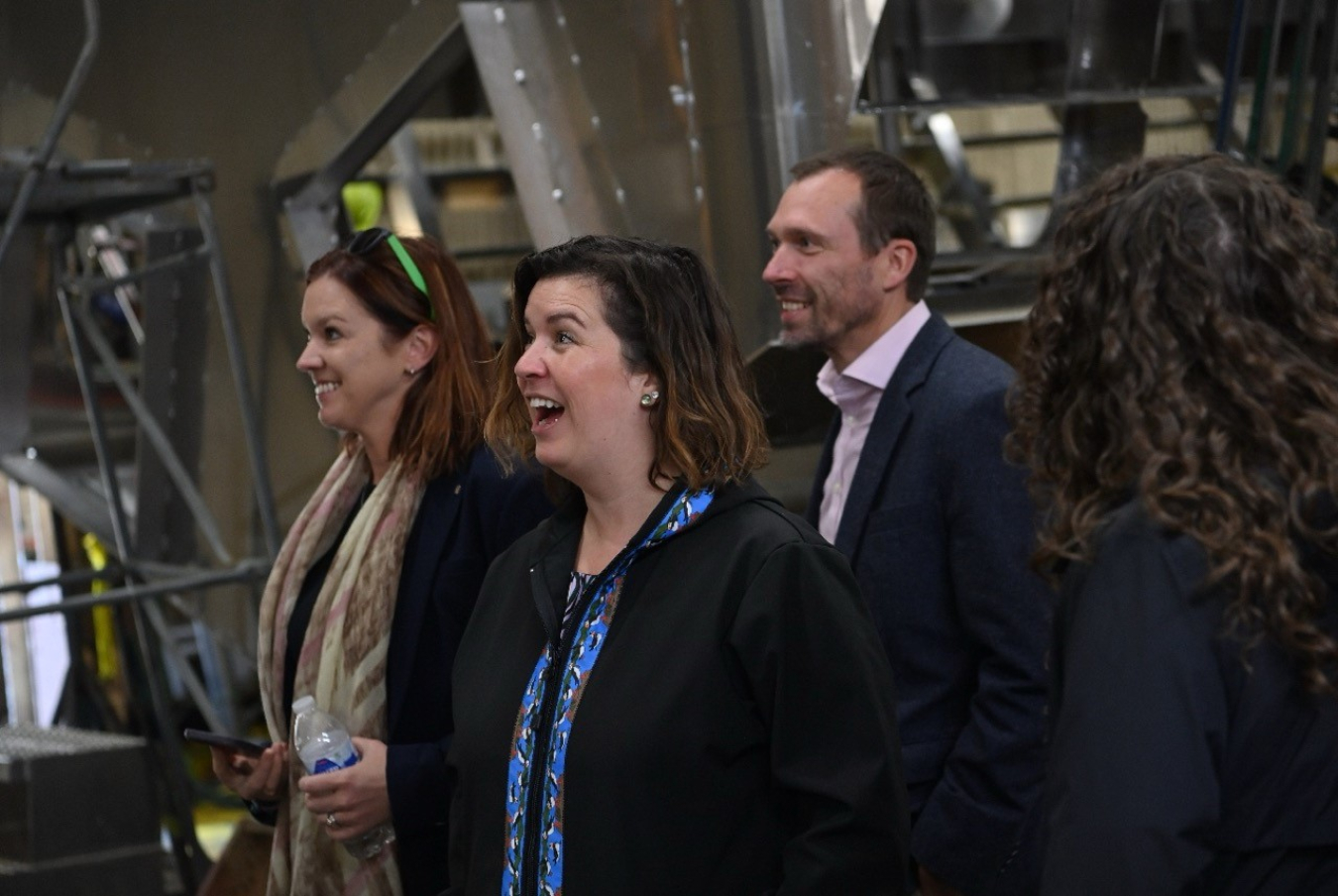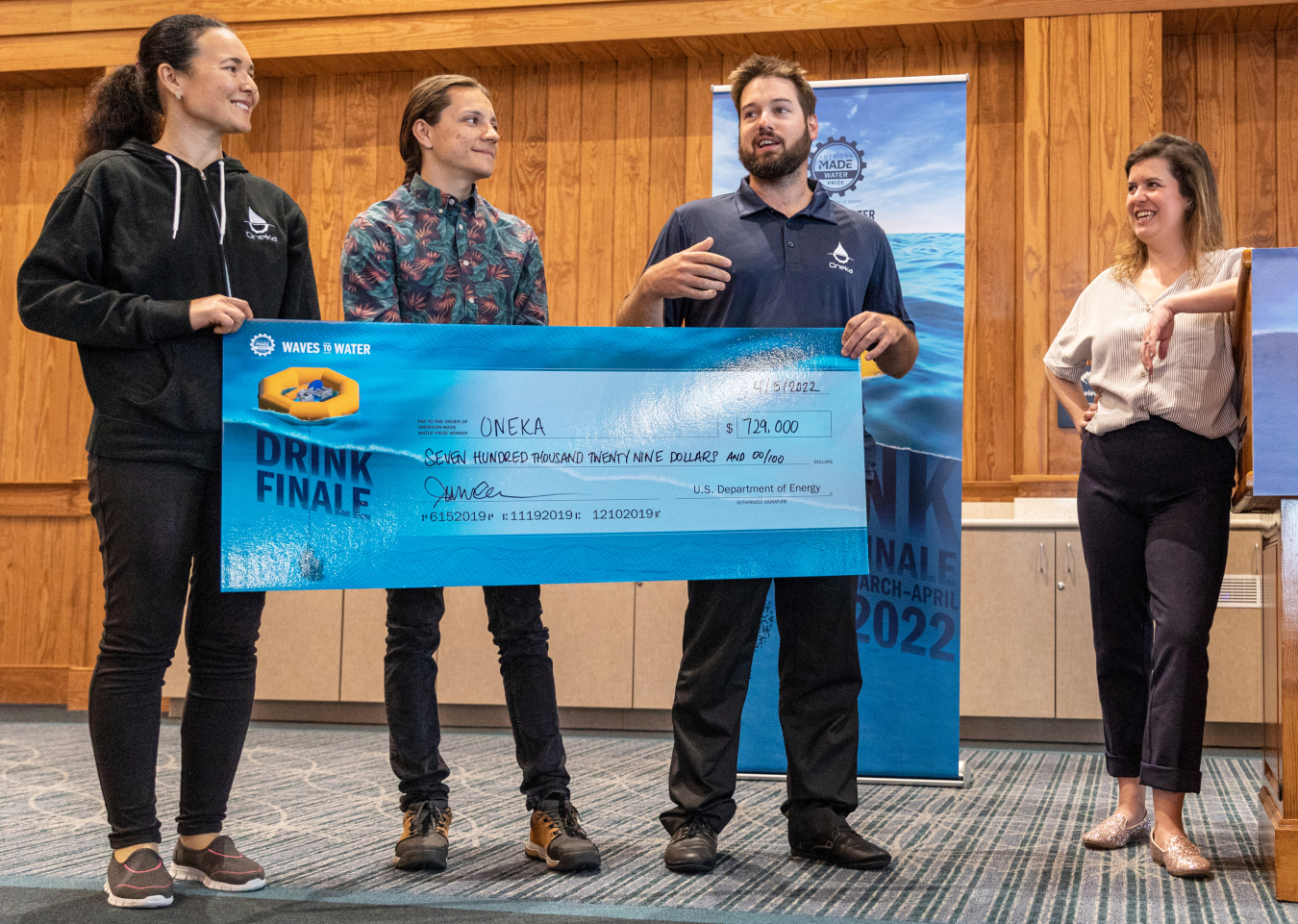Jennifer Garson, the outgoing director of the Water Power Technologies Office, shares how saying “OK” to opportunities led her to working in clean energy and her thoughts on the important role water power plays in the clean energy transition.
Water Power Technologies Office
March 12, 2024It’s unfair to ask Jennifer Garson to pick a favorite national park. She has too many favorites—and for good reason.
In Yosemite National Park, Garson and her now-husband waded into the grassy valley to watch a meteor shower burst across a perfect black sky. In Shenandoah National Park, Garson and her 6-year-old son escaped the pandemic by hiking up through glowing fall foliage to visit the somber, face-like outcrop known as Stony Man. Although she had to lure her son with chocolatey trail mix, his reaction to “the unbelievable splendor of nature,” as Garson puts it, is one of her great joys. And in Denali National Park, a 20-something Garson took the 7-hour bus ride to camp by Reflection Pond right at the base of the famous Denali mountain.
If it’s not already clear, Garson is a nature aficionado. And her love blossomed when she was just a kid. Her family took her hiking and camping in Yellowstone and the Grand Canyon. She spent her childhood fishing and splashing in the creek behind her grandparents’ cabin in rural Pennsylvania.
“I love being in nature,” Garson said. So, it’s no surprise that she has dedicated her career to protecting it.
Garson is the outgoing director of the Water Power Technologies Office (WPTO) at the U.S. Department of Energy (DOE). Before WPTO, she spent some time in Tasmania where she saw solar-heated homes and Aboriginal art, shifted from law to pursue public policy in clean energy (even before clean energy was close to a sure thing), and said “OK” to every opportunity. Six years ago, she said “OK” to water power, which she said is often overlooked but is likely to play an even bigger role in the clean energy power system.
“Water power helped build this country,” Garson said.
Garson shared what Tasmanians taught her about the land, how hydropower helped protect Vermont from catastrophic floods, and what she will miss most about WPTO.
-
Ripple Effect
WPTO's Ripple Effect series features individuals whose impactful work will help advance hydropower and marine energy technologies to achieve a clean energy future.
You spent much of your childhood in nature, but that doesn’t always translate into an environmental career. What nudged you in that direction?
When I was a kid, we traveled a lot. I got to see how different people connected their communities to their environments. In St. Lucia, we went on hikes led by locals who told stories about the land. In Panama, we went to cacao plantations that helped support bird populations and habitat. In the United States, most people don’t have a deeper connection to nature, whereas people in these other places deeply understood the connection to their environment. But it was really Australia that made a difference for me.
What happened in Australia?
When I was an undergraduate at Kenyon College, I studied abroad in a program that took me across Australia providing a hands-on experience with conservation and resource management. I studied how people had (or had not) adapted to rainforests. I saw a house that had a solar-powered water still to purify water. For part of the program, I went to Tasmania and saw an area that had been flooded for hydropower. I lived with an Aboriginal tribe for a while as well, and in Sydney I studied urban Aboriginal art and how communities were trying to reclaim their history and heritage through modern art forms. Some Aboriginal tribes told stories that went back 100,000 years and connected their communities to their place. We certainly don’t have that here.
Was that also your first experience with water power?
My childhood was fueled by hydropower. I lived in Washington, and there are lots of hydropower dams in the Pacific Northwest. But I didn’t really understand where the power came from. But really, it was when I lived in Australia that I stood on a landscape and truly understood the ecological impact it took to create a hydroelectric facility.
So, what changed after Australia?
When I came back to Kenyon, I doubled down on not just my anthropology major—I added an environmental studies concentration. I also lived for two summers in Alaska where I got to see incredibly energy-rich areas but also the fragility of energy, particularly in the state’s rural and remote areas.
What happened after you graduated?
I thought I wanted to be an environmental lawyer, so I moved to Washington, D.C., to work at a law firm. I started dating my now-husband, who was in law school. But I was like, “Oh, no, thank you.” I didn't want to be a lawyer.
OK, so you rejected law. What did you choose instead?
I wanted to do something with environmental policy, so I ended up enrolling part time in George Washington University’s Master’s in Public Policy Program. When I was still in my master’s program, I started as a contractor at DOE doing something I absolutely love: smart grid and transmission. Of course, I think my parents thought I was crazy for wanting to go into clean energy.
Why?
At that time, 17 years ago, solar was exorbitantly expensive. Same with wind. We didn’t have LED light bulbs. So, I was going into what seemed more like a movement—and maybe one that would not take root. But my parents now live in Vermont with solar panels on their roof and newly installed heat pumps.

After you got your foot in the door at DOE, did you have to overcome any obstacles?
Oh, yes. But regardless of any obstacles, I would say, just say yes to opportunities. I started as a contractor with the Office of Electricity during the American Recovery and Reinvestment Act of 2009. Then, one of my friends put my resume in front of the hiring manager for the Office of the Chief Financial Officer and said, “You should hire her.” I interviewed, and they hired me as a federal employee. So, I started working on energy policy. But then two years into that, a friend who was in the Tech to Market program said, “Hey, I need someone to run a business plan competition for me. Do you want to do that?” I didn’t know what business plan competitions were, but sure, why not. I set up a whole national competition event with a $0 budget; I had to convince corporate partners, event spaces, foundations, and law firms to give me (as a government person) money to support catering and cash and in-kind prizes.
Wow. But something tells me that’s not all.
After that, I was asked if I wanted to do I-Corps, but for energy, and I was like, “OK.” Then the Office of Technology Transitions said they needed help, and I said, “OK.” After having my child, I became the chief of staff for renewable energy. I also helped set up the American-Made Challenges network because we saw an opportunity to use prizes to encourage entrepreneurs and innovators to apply for funding.
How did you end up at WPTO?
Alejandro Moreno, the former WPTO Director, said to me, “Before you ever decide to leave government, you should join WPTO.” So, almost six years ago, I joined WPTO. And three years ago, Alejandro became the deputy assistant secretary for renewable power, and shortly thereafter I became the acting WPTO director. Again, an example of “just say ‘yes.’” Even if you're not 100% sure that you're equipped with the right skills, chances are if someone has asked you to do something, there's a reason.
After six years immersed in water, can you explain why Americans should care about water power?
Water power helped build this country. It helped build our industries. We’re not going to build hydropower the way we did in the past, but there's so much room left to modernize these assets and build hydropower in places that make sense, like irrigation districts or small, remote areas. Research shows we can bring more wind and solar online if we maintain our hydropower assets. And long-duration energy storage, like pumped storage hydropower, is going to be really important as we transition to an energy system of the future.
There are a lot of other hydropower benefits that are unaccounted for or undervalued—whether that's the creation of recreation areas, campgrounds, boating areas, navigation, or flood management support. I was in Vermont this past summer, and there were historic, catastrophic flood events. There were several towns that, if they didn’t have that hydropower dam, the flooding would have been even more catastrophic.
Hydropower is a key linchpin for reliable power. But we need to do it more environmentally sound and in a way that is aligned with communities and respectful to Indigenous rights and knowledge.

What about marine energy?
We don’t understand a lot of the ocean because we lack power out at sea. We know more about the surface of Mars than we do about the surface of our ocean floor. We’re now seeing actual in-water demonstrations of ocean-observing systems powered by marine energy. Yes, they're at the watt and kilowatt scale. But even that can help power water desalination systems and provide access to clean drinking water.
Some of the larger-scale devices, particularly from tidal power, are producing meaningful power right now on the grid in places like Europe and the United Kingdom. Marine energy is probably the most nascent renewable, but there's just enormous potential there.
Is there a WPTO accomplishment that you’re most proud of?
There’s a lot. I’m very proud of the Waves to Water Prize. When my son was 5, I took him to see the Ocean Observing Prize water tank testing, and now he wants to be a marine biologist or an ocean robot engineer. We’ve had 32 communities that received technical assistance through the Energy Transitions Initiative Partnership Project, which supports remote and island communities to transition to clean energy. On the hydropower side, we’re trying to push the margin of hydropower manufacturing.
It’s hard to pick a favorite. But the hardest thing for me to leave is the people. The people who I have had the opportunity to work with here are incredible. There are so many willing, creative, public-service-oriented people who want to make a difference.

What will you do next?
As you can see, I'm a good strong generalist, but I'm not leaving the climate or clean tech world. And no matter what my next role is, I still want to address one of the key barriers to advancing innovation: How do we continue to make federal funding more equitable, transparent, and accessible? With clean energy, we have to move fast, and we have to move smart. If we make funding inaccessible, we’re limiting the potential innovations.
And I’ll still be advocating to advance water power because people often forget about it, and I think that's a mistake. Water power is going to play an even bigger role in the future. Don’t undercount water.
Catch up on WPTO's other Ripple Effect profiles and the Office of Energy Efficiency and Renewable Energy's Clean Energy Champions.
And stay in the know with WPTO! Receive the latest information on funding opportunities, events, and other news by subscribing to the Hydro Headlines newsletter, as well as the Water Column and comprehensive Water Wire newsletters.

